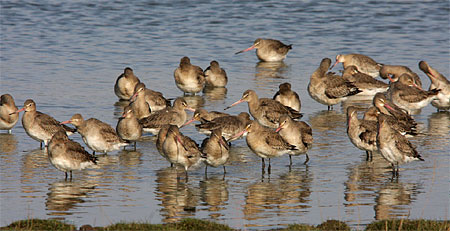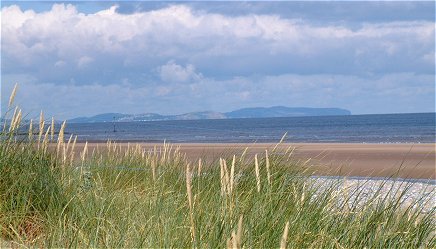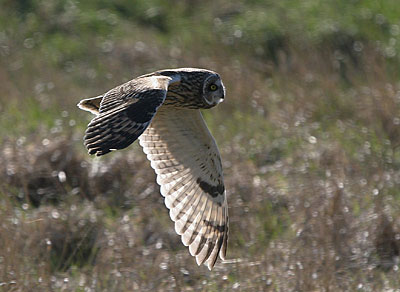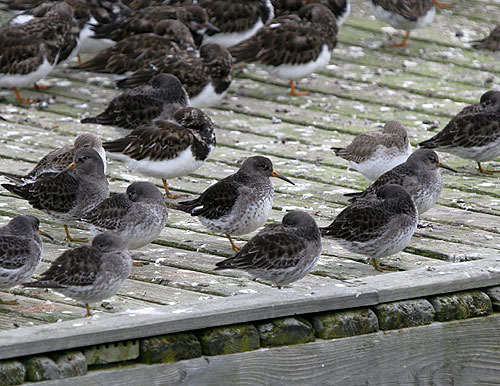Site menu:

April 2009 Newsletter
Dee Estuary WeBS Report 07/08 Review.
Voluntary Wardens Needed at Neston Reedbed.
North Wales Breeding Bird Atlas.
March Bird News.
Forthcoming Events.
Latest Newsletter.
Dee Estuary WeBS Report 2007/08 - Review
The Dee Estuary Wetland Bird Survey Annual Report 2007/08 has now been published, compiled by Neil Friswell and edited by the Dee Estuary WeBS Coordinator, Colin Wells. If you are a WeBS counter you will be receiving your free copy, otherwise please contact the RSPB at Burton Point Farm (Inner Marsh Farm) for details of price etc, ring 0151 336 7681.
As usual the WeBS report gives details of the counts undertaken by the volunteers who are out every month - whatever the weather! New counters are always welcome, please ring the above number if you are interested.
The WeBS year is from July to June and there are tables throughout the report giving counts for each month plus max yearly counts going back 20 years, and graphs illustrating trends going all the way back to 1980. All fascinating stuff for someone like myself who takes a keen interest in the fortunes and migrations of the commoner species on the estuary.
The report gives data that shows the Dee Estuary is of International Importance for seven species and of National Importance for a further seven species.
As this article is supposed to be a review rather than a summary I won't give much away in the way of detail (you'll have to read the report to see the data!) but I will make some short comments on a handful of species of particular interest to myself, as follows:
Firstly the winter of 2007/08 was another wet, windy and mild one which means numbers of some wader species were relatively low with many birds presumably staying further east on North Sea coasts. Teal numbers were also low probably for the same reason.

Great Crested Grebe numbers seem to have reached a plateau of between 50 and 60 on the estuary over the past few years, they were as low as 25 in 2003/05. Contrast this with the 246 counted in 1993/94! However, recently a large wintering flock has been discovered off North Wirral and these reached a peak of 274 on Feb 11th 2008, there was an even higher count of 435 during the winter which has just ended (08/09). As these can be counted accurately only in exceptionally calm conditions the counts are usually made on non-WeBS days and are included in the report as supplementary counts.

Black-tailed Godwit numbers reached record wintering numbers in 2007/08 with a max of 6,298 on Nov 11th 2007, although this is slightly below the max reached in the autumn of 2004 when there were 6,452. The Wash and the Dee Estuary remain the two top sites in the country for both migratory and wintering birds.
Tern numbers are almost certainly under recorded by the WeBS counts, but the 1,333 Sandwich Terns counted in July 2007 will undoubtedly confirm the Dee as one of the most important post-breeding sites in the country for this species.
Voluntary Wardens Needed to Protect Neston Reed Bed
 Once again the
RSPB are organising voluntary wardening at Neston Reed Bed, the scheme will
begin March 28th and run through until the end of May. Wardening will take
place each evening in order to protect this important habitat from
disturbance. I know in the past this scheme has
attracted birders who have realised what a good opportunity this location is
for some serious birdwatching with the possibility of seeing migrating
Ospreys and Marsh Harriers, large numbers of Little Egrets flying in to
roost, Bearded Tits, Hen Harriers, Short-eared Owls and the numerous birds
which breed in the reed bed. If you are interested please contact Geoff Robinson (Geoffrey.Robinson@rspb.org.uk),
telephone 0151 336 7681.
Once again the
RSPB are organising voluntary wardening at Neston Reed Bed, the scheme will
begin March 28th and run through until the end of May. Wardening will take
place each evening in order to protect this important habitat from
disturbance. I know in the past this scheme has
attracted birders who have realised what a good opportunity this location is
for some serious birdwatching with the possibility of seeing migrating
Ospreys and Marsh Harriers, large numbers of Little Egrets flying in to
roost, Bearded Tits, Hen Harriers, Short-eared Owls and the numerous birds
which breed in the reed bed. If you are interested please contact Geoff Robinson (Geoffrey.Robinson@rspb.org.uk),
telephone 0151 336 7681.
North Wales Breeding Bird Atlas
The North Wales Breeding Atlas team are asking for volunteers to help survey this fantastic area. As well as the Welsh side of the Dee Estuary we have all of the North Wales coast, Clocaenog Forest, the Clwyd Range, the whole of Snowdonia, the Lleyn Peninsula, Anglesey and more!! This an excellent opportunity to spend some great spring and summer days birding in Wales whilst doing something really useful to help the birds. There is an informative and interesting website www.northwalesbirdatlas.co.uk which includes a link to download the Autumn and Spring Newsletters, as well as contact details. Below is an article by Dr Anne Brenchley who is one of the Atlas Coordinators.

Make Your Records Count - North Wales Breeding Bird Atlas
The second season for our local Breeding Bird Atlas is looming and we have
a long way to go to achieve 100% coverage of all the tetrads in the North
Wales area (1826) by 2011. We have now downloaded all the available records
from the 2008 season and only 30% of the tetrads have breeding records.
Many of these tetrads only have a handful of records and as we can estimate
that most tetrads on average should have 40-50 breeding species, your
records are vital to this major volunteer conservation project.
A lot more information can be obtained from our local Atlas website:
www.northwalesbirdatlas.co.uk where we are beginning to place
provisional distribution maps so that volunteers can check out where the
gaps in information are most notable.
How can you help? Do you have birds breeding in your garden? When you are out walking the dog or birdwatching this summer, you may see evidence of House Martins, Swallows or Swifts breeding in local buildings. Do you have a local rookery that you can count? If so then we would like to use those records to help with the Atlas. Other species that are currently under-recorded are all the owls, Cuckoo, Pied Flycatcher and Green Woodpecker. Do you see or hear any of these species? Records are needed at tetrad level, which is a 2x2 km square - 4 squares on an OS 1 :50000 map) and submitted either online or in paper format as Roving Records. However, if you are not sure about naming/numbering tetrads correctly then details are provided on the website or from your local Atlas Organiser (in this case me). Roving Records forms can be down loaded from the national Atlas website www.birdatlas.net or again obtainable from me.
Adopt a tetrad There are 1826 tetrads in North Wales and at the end of the 2008 season 70% of these had no records of species present with Breeding Codes associated with those records. You may live in one of these tetrads. One other way to help is to adopt a tetrad and see for yourself how many species breed in this quite small area. It is a good way to discover some forgotten corners of your local patch and you could make a real contribution to this project. So adopt a tetrad and your challenge for the year is to see how many species you can find in that tetrad between 1 April and 31 July and discover how many of those species are actually breeding in the tetrad.
Finally, if you are a photographer and would be interested in having some of your photographs (habitat shots or pictures of any of our breeding birds) published in our Atlas in 2013, please contact us.
If you wish to
help please contact Anne Brenchley,
anne.brenchley@btinternet.com,
or see contact details at
www.northwalesbirdatlas.co.uk.
We need your help - Make your birdwatching count.
March Bird News
 We
had high spring tides and strong west winds this month, but unfortunately not at
the same time! Consequently the tides didn't cover the marsh at
Parkgate which
was a bit disappointing, but we still got great views of Hen Harriers and
Short-eared Owls. The best views of Short-eared Owls were to be had late
afternoons at both Parkgate and
Burton. At Parkgate the birds were often really
close and sometimes displaying giving great views but, as has been the case all
winter, Burton Marsh was the place to see large numbers - max was 27 on Mar
15th. It really has been a remarkable winter for these birds. Left above:
Short-eared Owl at Parkgate March 29th, © Steve Seal.
We
had high spring tides and strong west winds this month, but unfortunately not at
the same time! Consequently the tides didn't cover the marsh at
Parkgate which
was a bit disappointing, but we still got great views of Hen Harriers and
Short-eared Owls. The best views of Short-eared Owls were to be had late
afternoons at both Parkgate and
Burton. At Parkgate the birds were often really
close and sometimes displaying giving great views but, as has been the case all
winter, Burton Marsh was the place to see large numbers - max was 27 on Mar
15th. It really has been a remarkable winter for these birds. Left above:
Short-eared Owl at Parkgate March 29th, © Steve Seal.
The spring migration got off to an early start with the arrival of the first White Wagtails on Mar 4th but from then on it followed a very similar pattern to the previous two years with some glorious spring weather mid-month then a return to strong north and north-westerly winds which stopped the migration dead in its tracks. As usual the most numerous (tabulated) migrant were the Wheatears, max count was 14 on the Hoylake Langfields on the 30th. There was an apparent passage of Stonechats with up to eight at Leasowe Lighthouse between 1st and the 6th, six at Parkgate on the 7th, eight on Burton Marsh on the 9th and five at Riverbank Road, Heswall, on the 11th. There was also a large movement of Pied Wagtails early in the month with 66 at Gilroy Nature Park, West Kirby, on the 1st and 38 near Leasowe Lighthouse on the 5th.
| Species | 2009 | Location (09) | 2008 | 2007 |
|---|---|---|---|---|
| White Wagtail | 4th March | Hoylake Langfields | 9th March | 13th March |
| Wheatear | 14th March | Burton Point | 13th March | 12th March |
| Sand Martin | 15th March | Hilbre | 16th March | 15th March |
| Swallow | 16th March | Leasowe | 15th March | 16th March |
| House Martin | 30th March | Inner Marsh Farm | 11th April | 1st April |
| Willow Warbler | 31st March | West Kirby | 31st March | 3rd April |
| Whitethroat | 11th April | 15th April | ||
| Swift | 22nd April | 16th April | ||
| Cuckoo | 23rd April | 15th April |
Out to sea we had our first Arctic Skua and Gannet of the year on the 1st, and the first Sandwich Terns on the 23rd. The most impressive species in terms of numbers has been the Common Scoter with a max of 6,000 to 7,000 of Point of Ayr, I believe this to be the highest count off the Dee Estuary recorded in recent times. A Glaucous Gull and a Black-throated Diver were off Point of Ayr on the 26th. At least 20 Red-throated Diver were off Hilbre on the 1st and 49 was the maximum daily count of Little Gulls, on the 21st.

Mar 13th, © Steve Seal.
Wader numbers noticeably decreased through the month but there were still good numbers of Black-tailed Godwit - max count was 717 at Gilroy Nature Park, West Kirby,. Purple Sandpiper is a species that often peak in late February or March and the highest count on the pontoon at New Brighton Marine Lake was 23 on the 13th, there was also 211 Turnstone in the area. Avocets reached 15 by the end of the month at Inner Marsh Farm. 35 Snipe was a good count in the flooded field at Gilroy Nature Park, West Kirby, on the 29th.
Numbers of Brent Geese were still high by the end of the month with at least 60 but down on the 140 present on the 5th. 22 Red-breasted Merganser was a good count off Hilbre on the 13th.

Rarer birds included at least 10 Waxwings in West Kirby on the 10th and 11th. Black Redstarts were seen at Dove Point, Meols, and Deeside Industrial Estate. The Bittern which has spent the past few months in the marsh off Parkgate was reported only once, on the 12th. Two Lesser Spotted Woodpecker were in Stapledon Wood, Caldy, on the 17th. Up to four Ravens have been in the West Kirby and Heswall area through the month, presumably these are non-breeding birds. There was a very early Tree Pipit on Hilbre on Mar 19th, this is the earliest ever recorded for Cheshire and Wirral, previous was Mar 26th 1966 at Tatton Park.
Richard Smith.
What to expect in April
The spring migration really gets under way this month and there should be good numbers of Wheatears, White Wagtails and Yellow Wagtails plus the arrival of all our regular warblers such as the whitethroats and Grasshopper Warbler. Whimbrels will be passing through on passage and we should get a good number of Avocets at Inner Marsh Farm hopefully 20 or so. Black-tailed Godwits numbers at Inner Marsh Farm should reach several hundred, these will include many adult birds on their way to Iceland to breed. It will be interesting to see if we get a spring passage of Black-tailed Godwits at Gilroy Nature Park as well, it was certainly a favoured site on the return passage late summer and autumn in 2008. Raptors on spring passage should include a few Ospreys and Marsh Harriers.
Last April we had over five thousand Common Scoters off north Wirral so lets hope they return. Also out to sea should be plenty of Gannets and Little Gulls as well as one or two skuas.
April is also often an excellent month for rarities - over the past two years we have had White-tailed Eagle, Black Kite, Red-breasted Flycatcher, White Stork, Great Grey Shrike, Spoonbill and Cattle Egret!
RSPB Recent Sightings: recent bird sightings from Inner Marsh Farm, Parkgate and Point of Ayr RSPB Reserves can be seen on the RSPB website (as well as this website!), go to http://www.rspb.org.uk/reserves/guide/d/ then click on the link to the appropriate reserves.
Forthcoming Events
April Highest Spring Tides (Liverpool)
Also see
Tides page.
9th April, 11.57hrs (BST), 9.6m.
10th April, 12.36hrs (BST), 9.5m.
26th April, 12.51hrs (BST), 9.5m.
Forthcoming Events
Organised by the
Wirral Ranger Service ,
Flintshire Countryside Service and/or the RSPB:
All these events and walks have bird interest, even those not advertised
specifically for birdwatching. No need to book for these events unless
specified - please check below.
Saturday 25th April, 9.30am start.
Migrants at Point of Ayr.
Join the RSPB experts this morning for a spot of birdwatching
(HT 12.00, 9.4m).
Further information: RSPB – 0151 3367681.
Meeting point: Smugglers Inn car park. Free.
Sunday 3rd May, 04:30hrs - 06.30hrs.
Dawn Chorus on Heathlands.
Experience this magical time of day and listen to the birdsong as the sun
rises over Heswall Dales and Cleaver Heath
Local Nature Reserves. Led by the Rangers and members of Wirral
Wildlife.
Suitable for all the family, sorry no dogs.
Meet Cleaver Heath car park, Oldfield Road off Quarry Road West and
Telegraph Road in Heswall.
Booking Essential. For further enquiries and to book call: 0151 648
4371/3884.
Tuesday 5th May, Wednesday 6th May, Thursday 7th May and Friday 8th May,
9.30am to 3pm.
Before they Tern Up!
Help prepare the
Gronant site for the arrival of Little
Terns for their breeding season. There is lots of practical work to
undertake to ensure a comfortable stay for the last colony in Wales.
Meet at Presthaven Sands Holiday Park entrance, Gronant, SJ089841. For
more information contact Adrian Hibbert by email (adrian.hibbert@denbighshire.gov.uk)
or telephone 01745 356197.
Wednesday 6th May & Saturday 9th May, 1pm - 3pm (both days).
Little Tern Volunteering Taster Day.
Gronant holds the only colony of Little
Terns in Wales. Every year, volunteers help to protect these rare seabirds
during the summer nesting period. These taster days will give you the
opportunity to meet the Wardens and the volunteers and to get a feel for
this important work.
Meet at Presthaven Sands Holiday Park entrance, Gronant, SJ089841. For
more information contact Adrian Hibbert by email (adrian.hibbert@denbighshire.gov.uk)
or telephone 01745 356197.
Sunday 10th May, 4.30am start.
Dawn Chorus Walk.
Join members of Wirral Wildlife and Wirral Countryside Rangers to hear
bird song at its best, as returning migrants join our resident birds, to
claim their territories.
This is a (very!) early morning walk through heathland and woodland,
starting at Cleaver Heath Local Nature
Reserve on Oldfield Road, Heswall.
Details: Mike Maher 0151-342-4249
|
 |
The blank (UK) Birding Webring is a collection of quality birding web sites that are based in the United Kingdom. Visit the webring homepage for more information, or A complete list of all the sites in the webring is available by clicking here. previous site in ring : random site in ring : next site in ring |